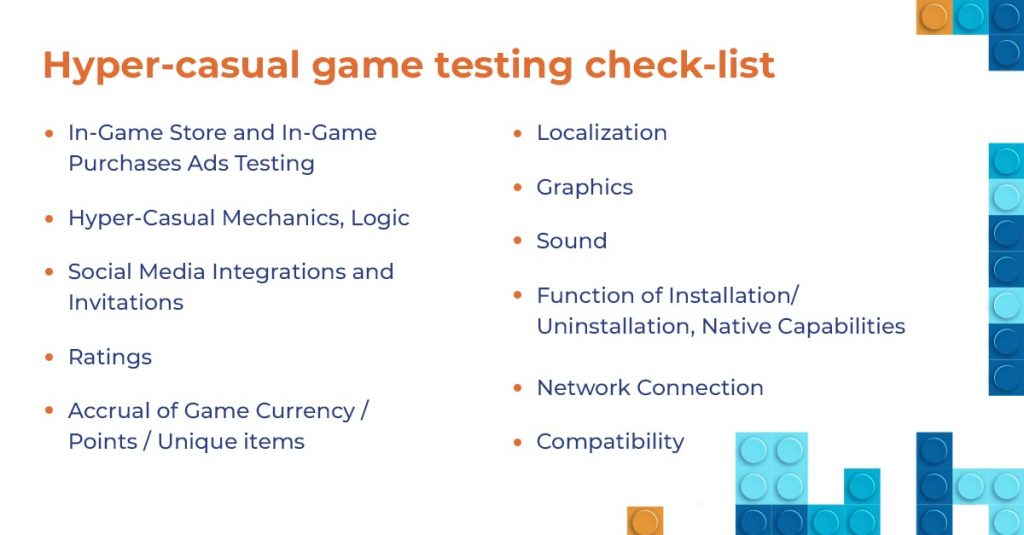- QATestLab Blog >
- Game Testing >
- Software Testing for Hyper-Casual Games: Simple Doesn’t Mean Easy
Software Testing for Hyper-Casual Games: Simple Doesn’t Mean Easy

A couple of years ago everyone said that hyper-casual games were having a moment. But now it’s clear that the “moment” has stretched into a longer trend.
According to statistics from the Dataconomy website, in 2020 such projects became the most downloaded on the market with 31% of all installations. And their IPM (Installs per 1000 Impressions) was up 70%. Impressive, ha?
What are Hyper Casual Games and Why are They so Popular?
Hyper-casuals are games without a certain plot with the most elementary mechanics and simple controls in a “tap to play” format. As a rule, the goal of the game is so clear to the player that there is no need to explain it. Literally “click and play.”
Because of their fundamental simplicity, such games are not only easy to play, but they make you want to play them over and over again. Unlike other genres, players can instantly immerse themselves in the process and get hooked on the game.

The secret is simple: they do not torment the user with boring training and are intended for the widest audience. Schoolchildren, adults, and your grandmother can play them. People who don’t consider themselves gamers can spend hours on Candy Crush, Fruit Ninja, Helix Jump or Doodle Jump.
The extra simplicity of such games is their strategy. Because of that most projects are very dynamic. Usually, producers compile statistics for all levels and look at which levels the players have the most problems (for example, they quit the game after they cannot complete the level for a long time). Then such levels are simplified by adding extra moves, boosters, and bonuses or completely removed from the game.
Another feature of hyper-casual games is that the levels and their generation usually are not done manually, but handled by special programs. The reason is obvious: since the game should be very simple, it should have more levels than in a regular game. The levels are rolled out in hundreds.
The benefit of such solutions is that players don’t need to have a flagman smartphone to play. This is the type of game that people play on their way to work or while waiting for friends at a restaurant. Not what they would play on Friday nights for hours like Dota 2.
This is a claim to success. Therefore, most of the highest-earning games in the App Store today are games of this format.
Why test?
To make sure that a game will be successful is essential for any game developer or game publishing company. And one of the fundamental conditions for user success is product quality. Even the greatest idea can fail if there are bugs in the end product that hinder the experience of the end-users.
Today hyper-casual games appear with a skyrocketing speed, so competition on the App Store and Play Store is too high. Users are quick in uninstalling those games that do not match their expectations. And if they leave a bad review, it can be the start of the “end”.
As publishers say:
“If someone uninstalled – we lose one user, if someone left a bad review – we lose 100 users”.
That’s why QA is vital for your hyper-casual game. Releasing a game without critical bugs is a sure way to improve user acquisition and monetization.
Testing is not limited to just checking for bugs and issues. True QA ensures that the visual design, features, and competitiveness come together to create a compelling experience for the players. So the intended fun factor and the emotional connectivity are not lost.
Let’s figure out what to check in hyper-casual games
At first glance, it seems that there is basically nothing to test in a game with elementary gameplay. But, you must admit that the simpler the game, the more noticeable even minimal errors are.

1. In-Game Store and In-Game Purchases
There are different types of purchases: 2 types of currencies (hard and soft) currency, individual boosters (tools that help to complete the game), boosters, and packages with boosters.
When the game has embedded purchases, it is extremely important to test them. The reason is clear:
Bugs in in-app purchases affect user engagement and game profit
So here is what you need to test:
- Make sure that all the items in the Game Store are available.
- Test all the redirections into the in-game store.
- Test purchases with real money.
- Check the accordance of all items’ value to the proper currency of the user’s country ($ for the USA and so on).
- Make a purchase and make sure that spent costs match the price in the Game Store.
- Check whether funds are not withdrawn from the user’s account when the purchasing process was finished unsuccessfully and reverse script (items received without successful withdrawal).
- Purchases need to be tested both on dev builds (sandbox accounts) and in real life (purchases with real cards).
2. Ads Testing
Another source of income in such games comes from advertising. There are 3 types of advertising:
- Interstitial – appears between levels.
- Ads for bonuses – triggered by a button, always indicates what bonus can be obtained for watching.
- Banners – ads that are hung in the designated places (in the level menu, etc.)
Advertising should always be displayed and located in the right places. There are also a number of affiliate programs that provide this advertising in the game, so it is vital to check that all partners can display their ads.
3. Hyper-Casual Mechanics, Logic
Any game, even with the simplest functionality, has a mechanic. It is necessary to verify that the game works as intended. For example, when you press the “shoot” button, a shot occurs, when you press the “forward” button, the character moves forward, the transition to the levels is carried out sequentially, and so on. By playing a game like a regular user, a QA engineer can determine gaps in its logic, find non-useful features, check levels for difficulty, etc.
Don’t forget to check the save progress option. Losing progress you’ve been working on for hours is an extremely painful experience.
4. Social Media Integrations and Invitations
Most games have an invite-a-friend feature and it needs to be tested also. Depending on the idea of the developers, the player can send an invitation to someone from personal phone contacts, or to friends from social network accounts. If the player receives bonuses for the invitation, then this option should be tested additionally. Another point is sharing player records/results on Facebook and other social networks. It also helps to attract new users. So properly working social media integrations are a win-win.

5. Ratings
The game may have a player rating table. The rating can be assessed by the number of levels passed, money earned, or other achievements. It can be shown by different criteria:
- Among friends (contacts)
- Locally by city/country
- Globally
6. Accrual of Game Currency / Points / Unique items
As usual, the essence of a hyper-casual game is about earning points/in-game money. This option should be tested especially carefully, as it is a competitive element that often attracts players. If the money is not credited correctly, or other players may receive it in an unfair way, this leads to player disappointment and negative reviews.
7. Localization
In such projects, the nationality of the players is often extensive. To reach different markets, developers should convert an app into the language of the local gamers. Localization doesn’t only imply translation but also considers local time, currency, date format, etc.
8. Graphics
Yes, this genre of games often has the simplest graphics. But it also contains a list of bugs, such as irregular textures, distorted images, and different types of visual glitches. Sometimes these bugs are just frustrating.
9. Sound
Music and sounds create the effect of user presence in the game. An error in sound coding can result in a gameplay mismatch with music and voice commands.
10. Function of Installation/Uninstallation, Native Capabilities
Any game, including hyper-casual games, has integration with the platform it is installed on. You need to check how the smartphone works while the game is running: make sure that the application can go into the background in case of an incoming call, can store, receive and send SMS messages, etc. It is also important to ensure that the installation and uninstallation of the game are easy and error-free.
11. Network Connection
Most hyper-casual games require a network connection. Modern mobile traffic options:
- Cellular data transmission: 2G, 2.5G, 3G, 4G
- Wi-Fi
- Mi-Fi – when the point distributes the Internet received via a cellular connection
It is necessary to understand how the game behaves not only when emulating high-quality, but when there is a problematic connection to the network or even connection loss.
Another point is that the player must be provided with a certain amount of content without a network connection (for example, he may not have the Internet on the road). Usually, 10-50 levels should be installed in the package with the game.
12. Compatibility
Another important QA stage for hyper-casual products is compatibility testing. Such games are made for maximum audience coverage – all ages and nationalities. So the game should perform its best on a huge number of devices.
A little output
So as you see, despite the simplicity of hyper-casual solutions, the range of elements that need to be tested is really wide. And each has a “red” priority because it influences the user experience. In such a high rivalry, any issue can be fatal. So ignoring a testing stage is not an option.
QA involvement will help you to release a high-quality game with good conversion, a positive user experience, and lots of loyal users.
If you consider giving Independent QA a try, write us down, let’s see, how we can work together for the benefit of your project!
Learn more from QATestLab
Related Posts:
- Game Check-Ups Overview: Why Do You Need Release Ready Testing For Sure?
- Balance adjustments in multiplayer games
- Updates Without Mistakes: Regression Testing in Game Development
About Article Author
view more articles







No Comments Yet!
You can be the one to start a conversation.